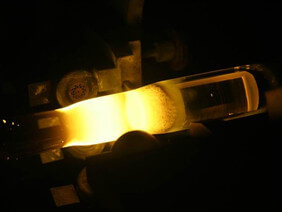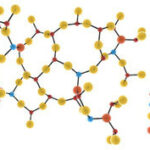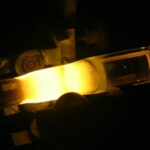- Home
- Research
- Fiber Research and Technology
- Research results
- Up to Boson Peak – Towards Enhanced Homogeneity in Optical Aluminosilicate Glasses
Up to Boson Peak – Towards Enhanced Homogeneity in Optical Aluminosilicate Glasses

28.03.2019
Optical fibers are powerful key components for miniaturizing next generation laser concepts addressing applications in personalized medicine, information technology, and materials processing. Structural heterogeneity on intermediate length scale limits optical attenuation of such fibers. The effect of co-doping with Al2O3 on homogeneity can be assessed from low frequency vibrational mode analysis.
By K. Wondraczek// J. Bierlich // V. Reichel
The fiber technology group at IPHT holds the distinguished competence of the complete research and technology chain; that is from preform material preparation up to fiber drawing and furthermore characterization of preform material and fiber. The rare earth doped core materials co-doped with alumina are prepared in-house by different technologies, for instances via modified chemical vapor deposition technology (MCVD) or via reactive powder sintering technology (REPUSIL). The current trend is for higher dopant capacities allowing for shorter fiber lengths and/or significantly higher power levels. However, typical strategies for compositional design of optical preforms remain empirical due to the lack of understanding the structural role of alumina.
In such materials, heterogeneity on intermediate length scale is a crucial factor for optical fiber performance, determining the lower limit of optical attenuation and Rayleigh scattering. It also impacts clustering and precipitation of active dopants, for example, in the manufacturing of high-power laser gain media.
Relations between chemical composition and the length-scale of heterogeneity can be explored through analysis of low-frequency modes using heat capacity data and Raman scattering so as to find accurate quantitative scaling parameters of binary aluminosilicate glasses. On the one hand, this enables a strategy for the design of glasses with high dopant capacity. On the other hand, it provides new insight at the structural origin of the excess in the vibrational density of states and the Boson peak of aluminosilicate materials.
Al-doped SiO2-REPUSIL preforms containing between 2.05 mol% and 7 mol% Al2O3were prepared by reactive powder sintering of nanoscale silica. Sample fabrication involved the doping of high-purity silica nanopowder with Al2O3and subsequent sintering followed by vitrification. The prepared porous green bodies had typical BET surface areas between 60 m²/g and 76 m²/g.
Samples of Al-doped REPUSIL preforms were analyzed in terms of low-frequency heat capacity and Raman scattering. Data analysis yields the average dynamic correlation length as a function of alumina content. In absence of macroscopic phase separation it was found to decrease from about 3.9 nm to 3.3 nm when mildly increasing the alumina content from zero (vitreous silica) to 7 mol% in SiO2. At the same time, the average inter-particle distance was found to increase slightly which is assumedly associated with the presence of oxygen tricluster species.
Structural analysis based on low-frequency vibrational mode analysis on binary Al2O3doped SiO2REPUSIL core material has thus evidenced the positive effect of increasing Al2O3content in SiO2matrix glass on its structural homogeneity structural homogeneity on a molecular scale.


